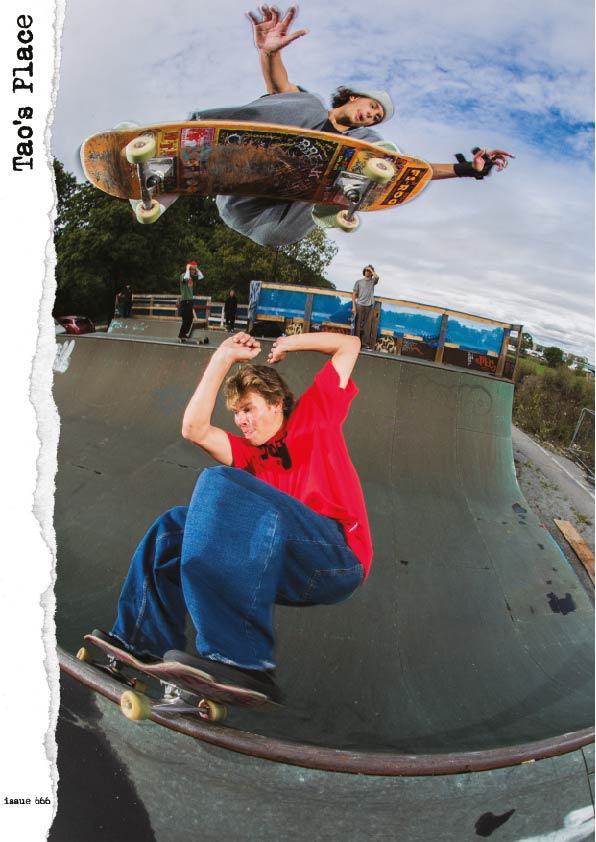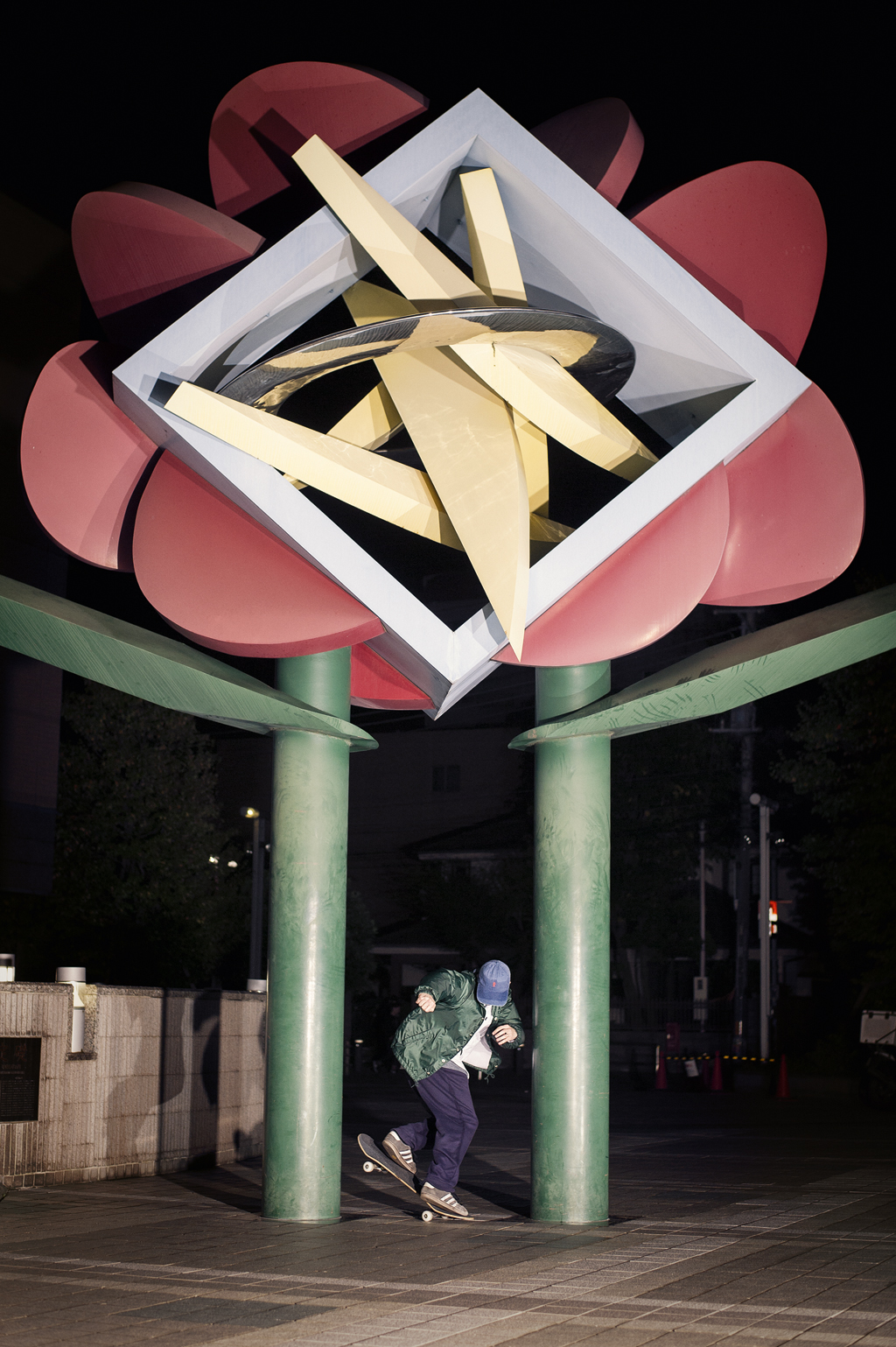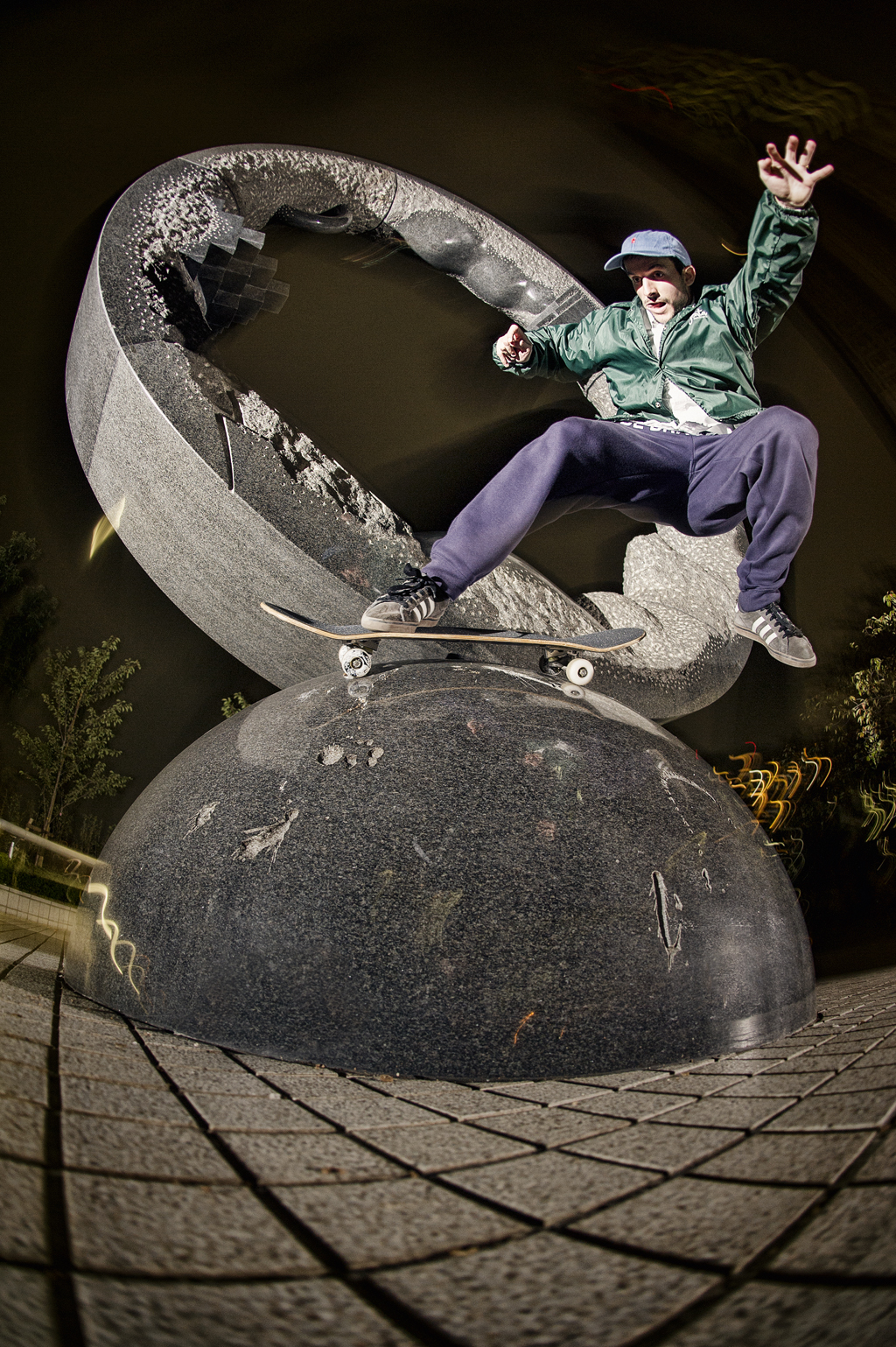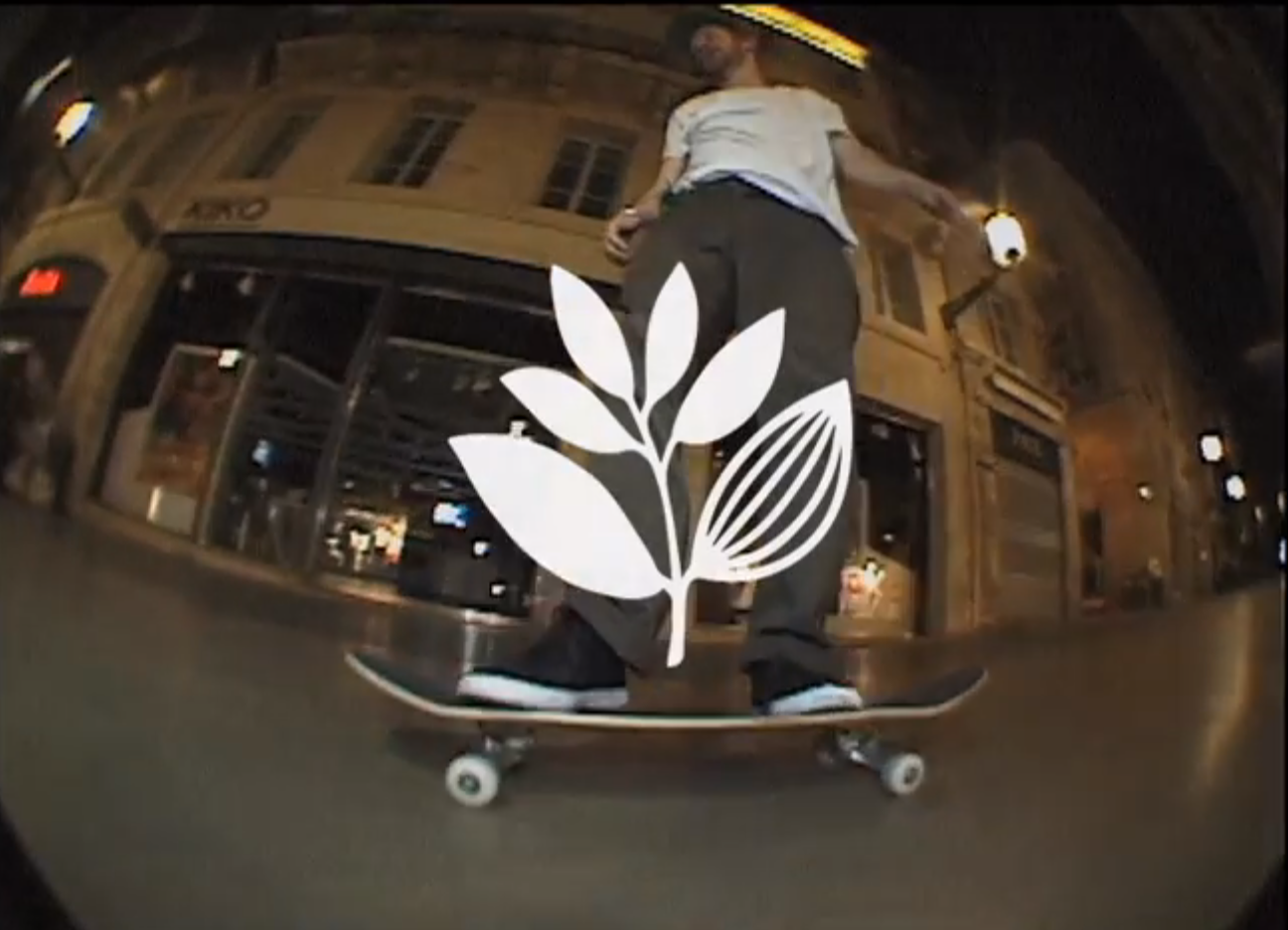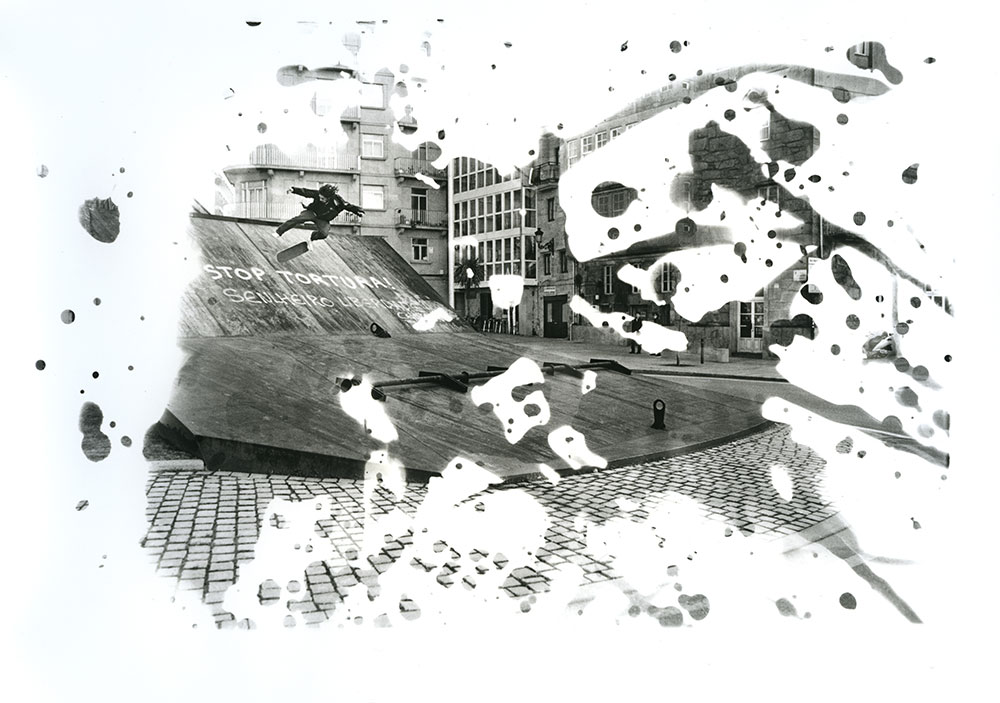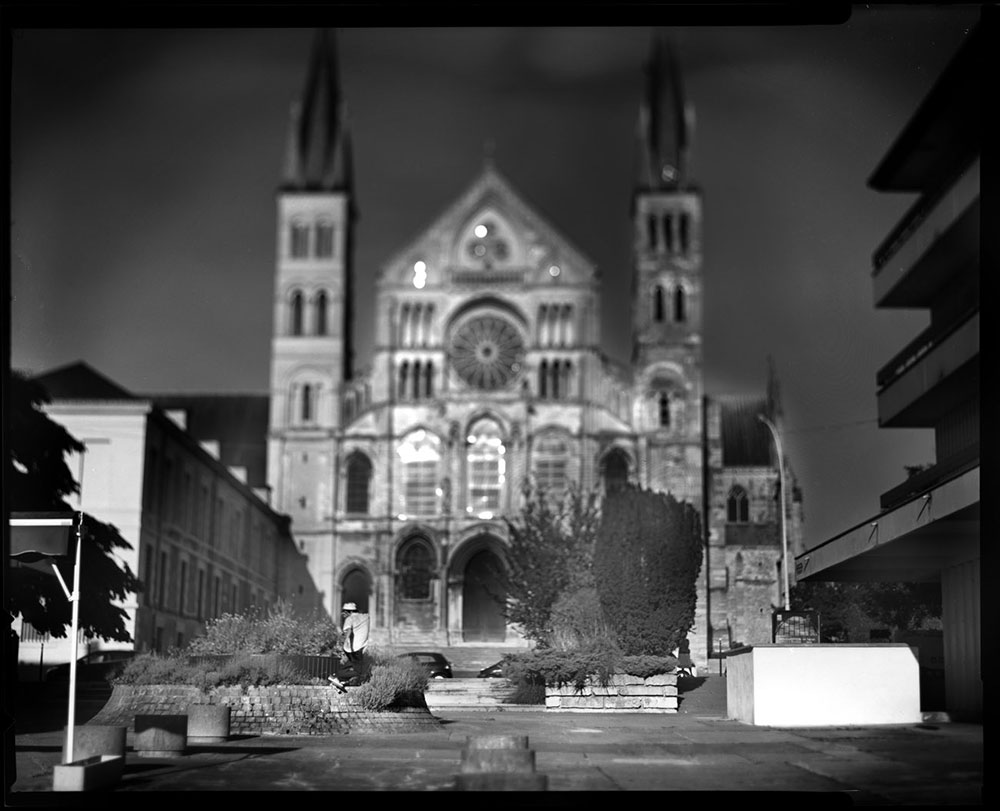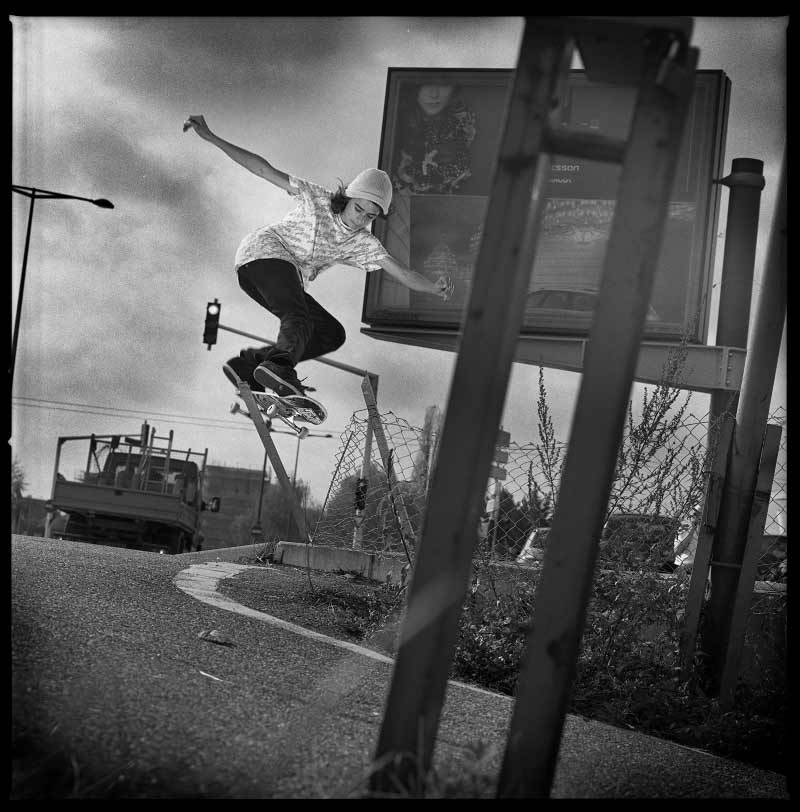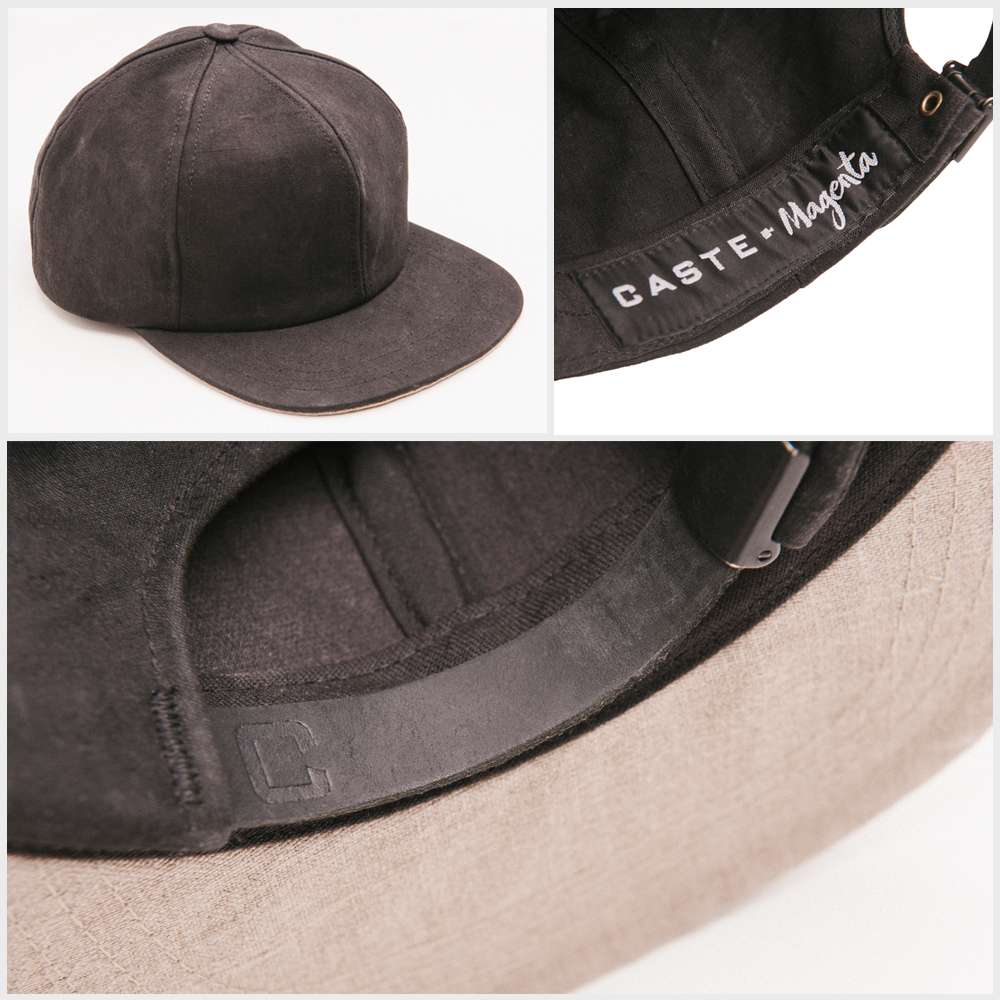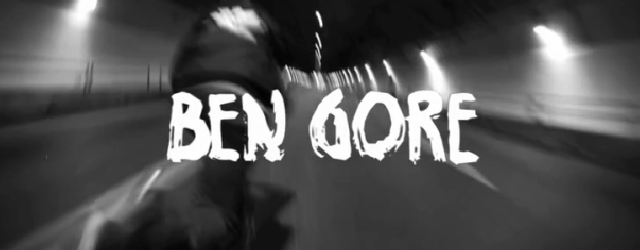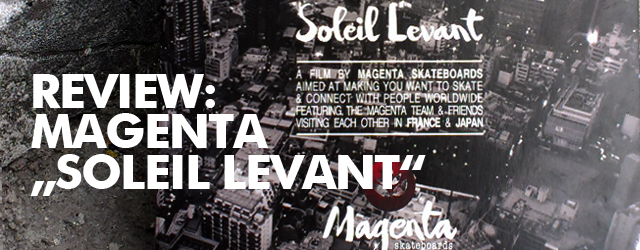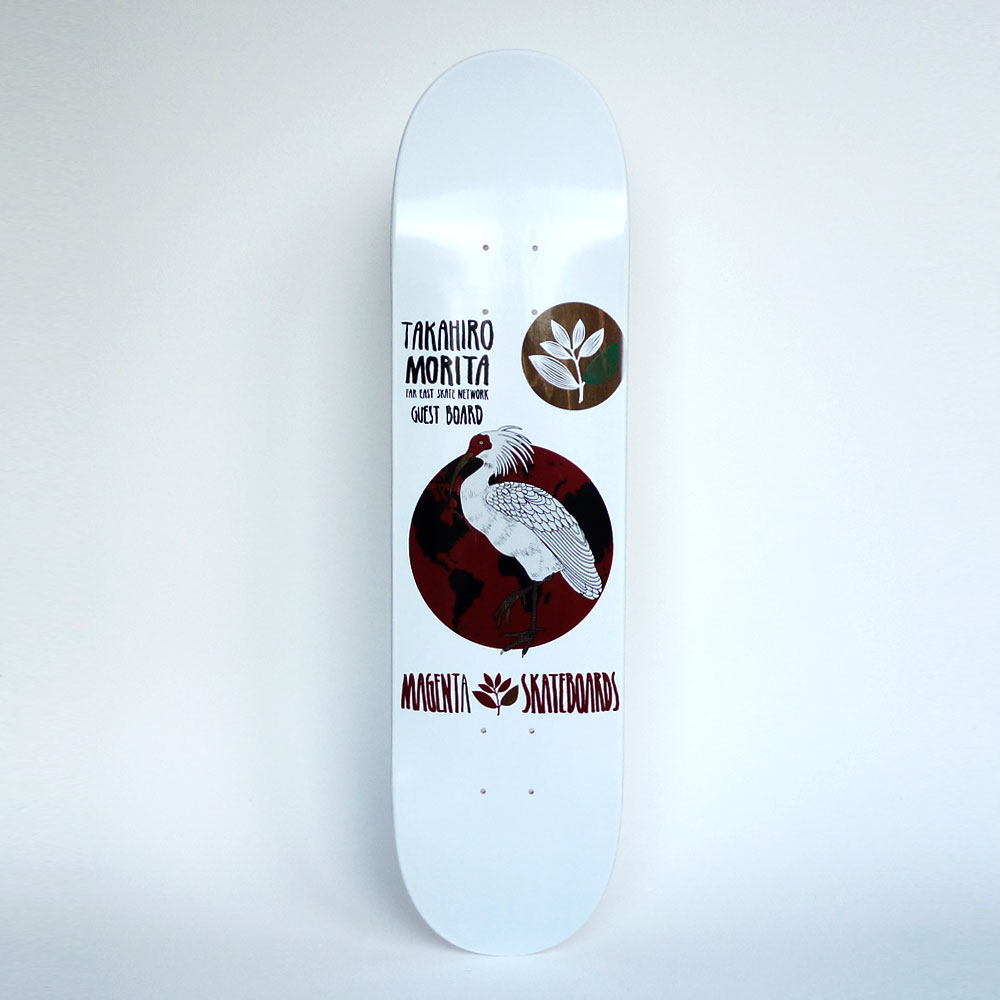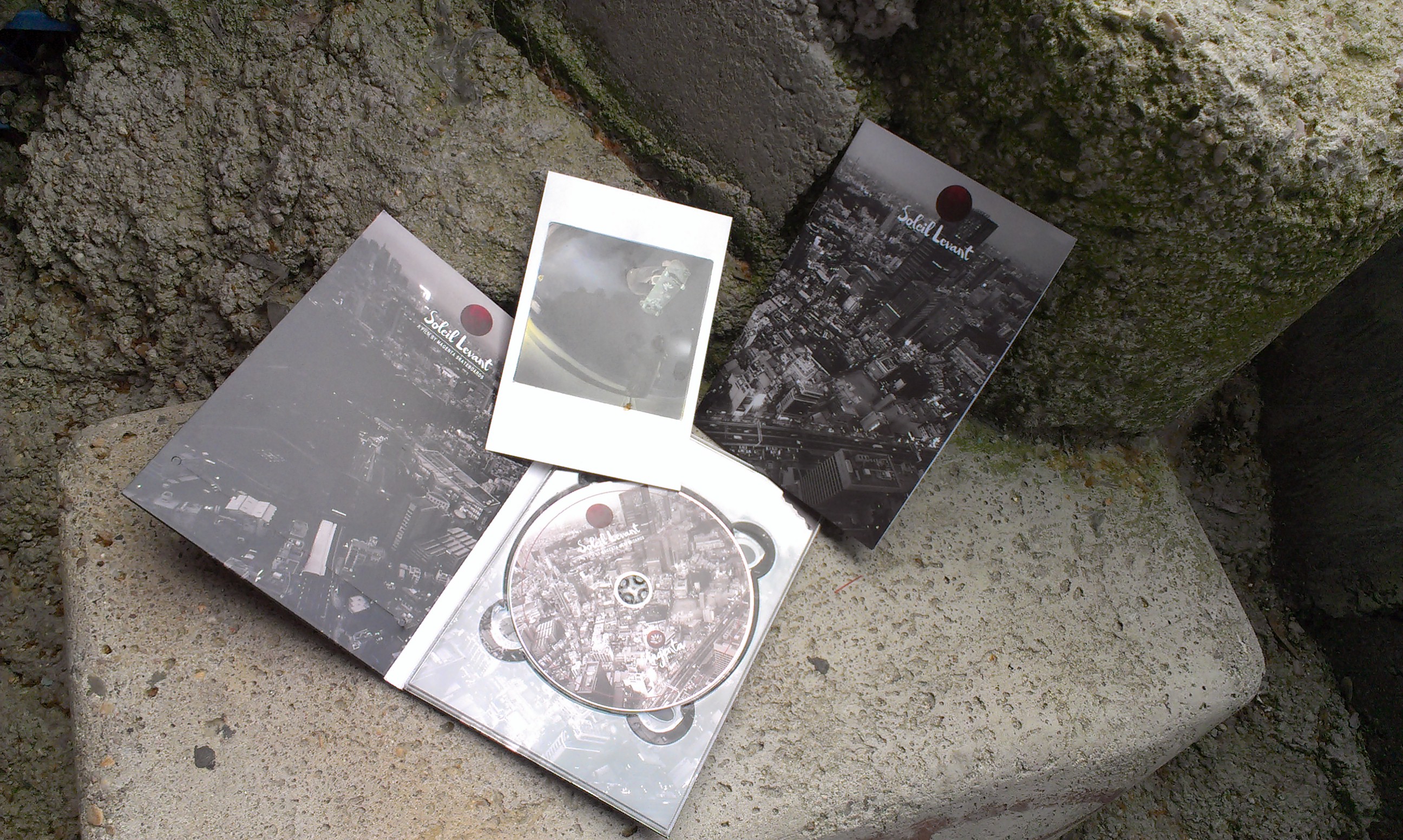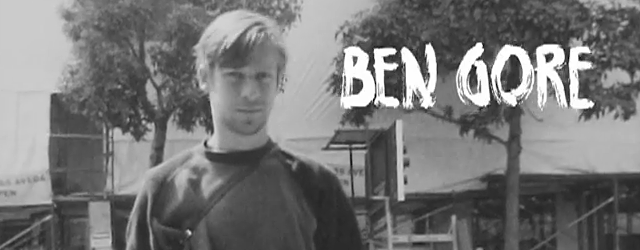Leo Valls’ life is pretty much a textbook example of everything that’s great about pro skateboarding: To him, it’s all about being an individual, traveling and exploring the world, seeing things through different sets of eyes. Now 28 years old, the Bordeaux-born Frenchman has been skating for 15 years, and he hasn’t been home much: Valls used to spend six months of the year in San Francisco for a while and has been visiting Japan every year since 2006. Accordingly, he knows a thing or two about the different cultural perspectives of Europeans, Americans and Asians. He has a creative mind and is one of the original members of Magenta Skateboards. He loves 90s skateboarding and exploring new cities with his effortless skating. And yet, speed, movement and personal expression are only as important to him as connecting with the locals. Since he’s never been featured in PLACE before, it’s a pleasure to have him in the mag, both online and offline…
Part I – offline: Face-to-face conversation in a Japanese bar in Nakano…
Let’s first talk about your Japanese friend, the one and only Takahiro Morita…
Well, there is a lot to say about him! He is a legend for any Japanese skateboarder. He is the guy who first understood that the Japanese approach to skateboarding was so specific and that it was really important for the Japanese scene to keep its own identity and not copy the rest of the world. In fact, the story begins in 1995, when Morita broke his leg while skating. He couldn’t skate for a few months and from there he started filming every session with his friends.
A few months later, he produced his first video “43/26”, the title referring to the latitude and longitude of Japan, and focusing only on the Tokyo skate scene. At that time, in his first opus, there was nothing really crazy or wildly different from what we could see in any other video from around the world. It was also in ’95 that he created his own company FESN (Far East Network) and two years later, in 1997, his brand Libe. His first big video project was to unify all Japanese skateboarders by filming them in their own cities around Japan. He filmed for more than five years for this project.
The final result came out in 2004: “Underground Broadcasting”, a video that for the first time showed what’s so special about the Japanese style of skating. The next step of his artistic video project was going to be “Overground Broadcasting” a few years later. He traveled the entire world for seven years to film this new opus, which became an international success when it finally came out with the famous Gou Miyagi part at the end…
The message of this second chapter was to show that skateboarding was a way to travel, to discover many different ways of thinking, of skating, and that it’s a very good way to open your mind and get more creative. In 2008, when the video came out, it was really like an earthquake on the skateboard world, and many skaters all over the world started to discover the Japanese way of skateboarding. So, in short, all this comes from inside the brain of Morita and the Fat Bros crew from Nakano.
When did you come here, to Japan, for the first time?
In 2006 it was my first time here. I immediately decided to come back every year.
There are some similarities between your approach to skateboarding and the way some people skate here in Japan. How would you define your take on skateboarding?
Well, first I respect all the different visions, styles and faces that make skateboarding what it really is. Second, I would say that I definitely don’t focus on the technical performance side. I’m more looking for an aesthetic part, trying to experience something personal. I guess that comes from all the influences I was exposed to when younger, when I started traveling, meeting people who were skating in different ways, plus I’m also influenced by my studies in Art History.
I’m more interested in the creativity, the character, the universe of each and every skater, more than his ability to reproduce a technical trick he might have learned over many days in a skatepark. I just want to say that there is not just one way to skate, and that’s what makes skateboarding so magic and attractive.
I’m more looking for an aesthetic part, trying to experience something personal.
Can you tell us a bit about your last experience during your trip to Perth in Australia?
It was also a really good one! We went there last year with the Magenta crew. It was my first time in Australia and, well, I have to say that the skate scene in Perth got its own personality, they do their own stuff with their own style, so it was really cool to spend time and skate with them.
Actually, we filmed them a lot while we were there and we gave them the first part of our Magenta video “Crossing The Perth Dimension”. They were really happy with that and they told me that a lot of teams had visited Perth already but we were the first ones that really made connections and filmed with them and gave them the opportunity to get some media exposure. I was really happy about it.
Part II – online: Conversation about the internet & digital life – done digitally, via email
What are your memories of the world and life without the internet?
Access to information and communication seemed more limited but I remember spending a lot of time dreaming, imagining stories, reading books and drawing. It was not so bad in the end, when I think about it now. I discovered the internet quite late, around the age of 13, if I remember it correctly.
What is your first memory of the web?
I think it’s when I realized that we can communicate with people anywhere in the world, without any limits of time and without burning units on my mobile phone, so that was really good! I especially remember doing my skate history lessons through the internet. I am part of that generation who had access to all the videos at once thanks to downloads.
I was able, in the space of a few months, to download a true collection of skate videos, which was all of 411, also the “Eastern Exposure” and the Zero videos. Attracted by all kinds of styles, I could get them all quickly thanks to the internet. So I spent a winter downloading, viewing and analyzing videos of all types, and exchanging them on CDs with friends. I quickly became fascinated by movies like the FTC “Penal Code 100A” or the Zoo York “Mixtape” which really had a great urban atmosphere and a special aesthetic.
What are the major changes that the web has generated in our society?
The ease and speed of search, communication, and exchange.
Do you believe that it was better before or after the advent of the internet?
I’m not sure about this formula “it was better before”. There are always ways to see things more positively. I think the internet is a good instrument as long as we know how to use it correctly and keep in mind where the limits are that we shouldn’t overstep. In my own experience, it really helped me to connect with the majority of the friends I met while traveling. My wife is American and the beginning of our long-distance relationship would have probably been way more complicated without this tool.
Do you use the internet to inform and educate yourself?
There are a lot of parallel channels of information on the internet. There is much to learn and discover, socially, artistically, historically. And yet, we must pay attention to the sources of information, and not become sheep. One has to find a balance between the mass media and “bad theories”. On the other hand, the internet is an excellent tool for so many things. You can, for example, learn all the skills to edit videos or how to use specific software, just by watching tutorials. But if you are really interested in something, my opinion is that nothing beats a good book on a focused topic.
How do you personally use the different social networks?
I naturally started to use Facebook mainly to stay in touch with people I met while traveling. Recently I also started to use Instagram, timidly, but most of the time it’s just to post stuff related to what we do in skateboarding. I am quite passive on social networks, I don’t think it’s a very natural way to communicate about personal feelings, but actually this year I’m trying to get more into them and to spread more stuff via those networks.
However, I find it very important to be careful not to share too private or personal information through these channels, especially about love and family life. I think it’s important to keep some personal stuff private by avoiding too much exposure on the social networks. When it’s about skating or passions to share, it allows others to discover things, and I think that’s great, but when it’s about personal life, I think it’s embarrassing!
What are the main advantages and disadvantages of these platforms to you?
It’s great to get close to people who are passionate about the same subjects. The skate community has broken so many boundaries since the advent of the internet, and everyone can express themselves. If we dig a little we can discover and track a lot of “underground” crews from all over the world that do great things in their corner without necessarily being represented by the mass media.
There are lots of very interesting guys that motivate and inspire us and come from everywhere, whether from Croatia, Brazil, Puerto Rico, the States, Korea or anywhere else. There is a lot of great stuff that remains unknown, but the internet is a really good way to discover and eventually get access to that. Also, I would say that the major problem with social networks is that many people, especially young kids, start losing social skills by spending too much time in this parallel and artificial world where, whenever you publish something on your profile, it’s all about the amount of likes you get. The real life with real people in front of you is definitely way more exciting!
If the internet was to suddenly disappear, which aspect of it you would miss the most?
Probably emails and Skype, which is so far probably the best way to chat with friends on the other side of the world. And probably also YouTube to listen to almost any music album that I love.
What is your outlook on print magazines, especially the ones from the skateboarding universe?
To be honest, I think that the printed press still seems a little too conventional at times. I would like to see more magazines take some risks, they should try more original things and find a different approach. Of course there are differences between all the countries and there are many excellent skate magazines today, but what I mean is that we could try to offer the young readers something less standardized, going deeper but also returning to the basics and the roots of why skateboarding is so unique and exciting.
Today, it is true that with the advent of the internet and all the new independent productions, we are beginning to see more talented rookie skateboarders in the press, people that are less known and less connected to the industry, which is obviously a really good thing! I hope it’s going to evolve in this way in the future.
Which do you prefer: buying a magazine or visiting its website?
The print magazine and website are now, in my eyes, complementary. However, I like to hold an object in my hands. A paper magazine or a DVD has the advantage of marking and crossing time without finishing in internet limbo.
More and more video parts are dropping every day on the web, what do you think of this?
It does not bother me because I still watch the exact same video parts that have influenced me for years. Look, even yesterday before going to skate, I was still watching the New York part in “Eastern Exposure”! We watched it with a small crew of friends, like we usually did when we were kids. The part in black-and-white set to Miles Davis, dude, these things will never get old!
Today, it’s great that everyone has a common place of expression. Next, it is also clear that there are too many images of skateboarding online and I guess we lost something there in terms of creativity and quality. It seems impossible for me to look at everything. You must have a minimum of critical thinking and know how to select the things you’re going to watch online, otherwise you’re going to lose your life getting lost on the internet.
What is your opinion about the fact that “too much information kills the information”?
Hmm, well, the avalanche of information is often used to produce content to sell advertising and create traffic and buzz on some websites. Media outlets generally share the same info and bludgeon the same images, obscuring the other content. I don’t want to dwell on the subject, but we recently saw an example of this in France with the attacks on Charlie Hebdo. There were loops of the same terror images on all the main media channels and newspapers for a week, thus completely ignoring and overshadowing the rest of the international news, which were equally dramatic.
Do you still buy CDs, DVDs and books in stores, or do you prefer to order them on platforms such as iTunes?
Except plane or train tickets, I rarely buy things online. The abundance of images on the internet makes it clear that owning a DVD, a magazine, or a book is much more interesting and enjoyable. I will take the example of our friend Josh Roberts from Perth, who sent us a DVD copy of his great local video “Domingo” by mail, which was actually a great surprise for us. It had a totally different effect on us compared to discovering it on YouTube in the middle of so many other new clips. We eventually went to visit him with the Magenta team to work on our project “Crossing the Perth Dimension”.
A part of this interview was done face-to-face and the other part by mail. What suits you better?
It is true that the questions about Japan in a Japanese bar with a Japanese beer in my hand were more inspiring than answering email questions about the web. I would say that it’s still more natural for me to have a real discussion in a face-to-face interview!
If you could change one thing related to internet matters, what would it be?
The option “mandatory week without internet”, which should be applied by all! My friends Vivien and Jean Feil are both aware, they gather every year for a week in a house in the middle of the forest without access to the web. Instead it’s all about various activities, like fishing and skating mini ramp.
Top 5 websites that you visit the most?
youtube.com
magentaskateboards.com/blog
theoriesofatlantis.com
chromeballincident.blogspot.com
easternfronts.tumblr.com
Top 5 websites that you hate?
Well, I do not really waste my time on websites that I hate.
Top 5 public figures that you found on the internet?
– Badbadnotgood
– Erik Truffaz
– Taro Okamoto
– François Damien (Belgian comedian)
– Kim Jong-Il
Top 5 video parts you’ve discovered on the internet?
– “Eastern Exposure 3”: NYC section
– “Parisien”: Soy Panday
– Zoo York “Mixtape”: Peter Bici
– Real “Non-fiction”: Mark Gonzales
– Heroin: Gou Miyagi
What is the future going to look like?
Skate sessions with Google glasses! No, I’m kidding, I just hope skaters everywhere will continue to connect with each other, to come together and inspire each other to push skateboarding in a direction that’s more and more creative.
Interview and Photos: Kévin Métallier

